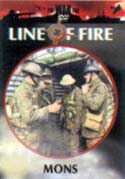
TRENCH REPORT: The Trip-Wire Grows! We have a new regular contributor, Tony Langley, Proprietor of The Great War in a Different Light website. He will be sending us large format images from magazines of the period. (link) Also, I've decided to offer space for unsolicited articles. Consequently, a second page has been added for the Trip-Wire. Page Two will be more image intensive and so you will see that I eliminated to double column formatting. Please send your comments. Walt Kudlick is this month's surprise columnist . . .This month we continue to emphasize the 90th Anniversary of the outbreak of the war, focusing on the battles of August 1914 . . . Frank Jordan has brought back an interesting reconnaissance report from his recent two week tour co-led by Tom Gudmestad. The Vimy Ridge Monument is going to be completely rebuilt in a huge two-year long project starting in the fall. The original quarry has been reopened to supply exactly matching stone work. I've seen nothing on this project on either the web or in the news. Please send a heads up on any articles you may come across on this endeavor . . . If you going to be anywhere near Northern New York State August 6-8, try to get to the WFA-USA annual seminar in Plattsburgh. They have an outstanding program planned. (link)
VETERAN OF THE MONTH |
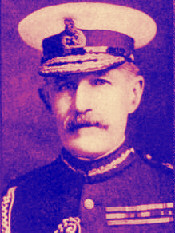
Gen. Sir Horace
Smith-Dorrien
1858-1930
Commander British II Corps at
Le Cateau
Click on Image for More Information
|
|
New at the Websites of the Great War Society and Our Friends
Click on Title to Access
|
|
At the Doughboy Center
At Legends & Traditions
At France at War
At WFA-USA
|

| This Month's
Special Feature

Opening Events
|
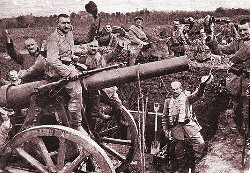
Victorious German Troops
After Fall of Antwerp

In the USA, we see slow rises in both suicide and homicide up to the time of World War I. After the war began, suicide fell while homicide rose. [However,] both suicide and homicide fell during and after World War II.
From: Homicide and Suicide in America, 1900-1998, David C. Stolinsky, MD
|
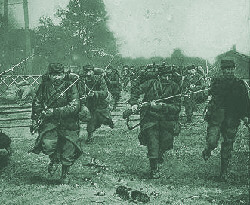
Contemporary Depiction of Early Battle

What Our Readers Like
Many of you send titles of books you like. The list below is made up of recommendations I've received during the last two months. The unique feature of the selections is that before I heard from you, I had never heard of any of these works before.
-
- Into battle: A soldier's diary of the Great War
- by John Bagot Glubb
- Tales of War
- by Lord Dunsany (Paperback - August 2002)
- Sailor of Austria Series
- by John Biggins
- Virago Book of Women and the Great War
- by Marlow (Paperback)
- Women, Men, and the Great War: An Anthology of Stories
- by Trudi Tate (Paperback)
- On Her Their Lives Depend: Munitions Workers in the Great War
- by Angela Woollacott (Paperback)
- Gentlemen Volunteers : The Story of the American Ambulance Drivers in the Great War
- by Arlen Hansen (Hardcover)
- Against the Specter of a Dragon: The Campaign for American Military Preparedness, 1914-1917 (Contributions in Military Studies)
- by John Patrick Finnegan (Hardcover)
- Pill Boxes on the Western Front: A Guide to the Design, Construction and Use of Concrete Pill Boxes 1914-1918
- by Peter Oldham
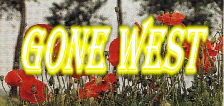 Sad news from our membership ranks. Old friend Christine Wood of Palo Alto, California and new friend Jim Minnoch of Manchester, New Hampshire, both passed away in July. Christine with her husband Peter were on the first battlefield tour I helped lead in 1991. They were both great traveling mates. Jim has been a frequent contributor to the journals and websites of both the WFA and TGWS. He made a presentation at the seminar last April in Kansas City. Both will be missed.
Sad news from our membership ranks. Old friend Christine Wood of Palo Alto, California and new friend Jim Minnoch of Manchester, New Hampshire, both passed away in July. Christine with her husband Peter were on the first battlefield tour I helped lead in 1991. They were both great traveling mates. Jim has been a frequent contributor to the journals and websites of both the WFA and TGWS. He made a presentation at the seminar last April in Kansas City. Both will be missed.
I received no news of veterans passing away in the last month, but the Great War still managed to make a new casualty. Several readers sent this same article from Reuters:
Aldo Busato, a retired 70-year-old Italian farmer in the Veneto died when a World War One bomb, part of his collection of military memorabilia, exploded while he was showing it to a friend in his garden. He died instantly. The man he was showing the bomb to was seriously injured, the local fire brigade said.
GREAT WAR 2004 EVENT CALENDAR
|
WFA-USA National Seminar
State University of NY,
Plattsburgh, NY
August 6-8, 2004 (program)
|
90th Anniversary, First Battle of the Marne
Mondement, Marne, France
September 5, 2004 (details)
|
The Outbreak of War: New Thoughts on 1914
Scottish Centre for War Studies (University of Glasgow)
September 8, 2004 (email for info.)
|
WFA-USA NE/NY Chapter Seminar
Marriott Hotel, Springfield MA
October 23, 2004 (link)
|
Send additions/corrections:
Email Response
|
 We must be prepared to put millions of men in the field and maintain them for several years.
We must be prepared to put millions of men in the field and maintain them for several years.
Winston Churchill, quoting Lord Kitchener
|
|
Page Two
|
Line of Fire: The Retreat from Mons
By Andy Melomet
Over the years Cromwell Productions in the UK has produced a wide variety of military history documentaries. Their release on the fighting retreat from Mons is one of six in the Line of Fire series dealing with The Great War. The other titles are Cambrai, The Somme, Gallipoli, The Kaiser's Battle-1918 and Life in the Trenches. These well-done modern productions feature animated battlefield maps showing both terrain and troop deployments and archival footage coupled with insightful interviews from military historians and atmospheric reenactments.
Within 5 days of the declaration of war the British Expeditionary Army was in France. In August 1914 this professional army met the Imperial German Army on the battlefield for the first time. The first Victoria Crosses of The Great War were awarded as a result of these actions. For the first time, the continuing chronic problem for the attacker in the First World War of how to deal with the quick firing defending machine guns and rifles was encountered. The primitive attacking tactics that were to be used by both sides in the First World War of mass ranks walking slowly towards the enemy guns were first used. And for the first time, the heavy casualties sustained by the attacking force were the result. The battle at Mons, the following 200 mile fighting retreat by the BEF, and its survival as an effective fighting force for immediate deployment in the Battle of the Marne is one of the great battlefield stories of World War I. British historians Jack Horsfall, Lloyd Clark and Duncan Anderson provide commentary and Bill McQuade on the actual battlefield gives the soldier's perspective.
I highly recommend the releases from Cromwell Productions for anyone interested in creating a library of military history videos. The Line of Fire series is available on VHS in the US and VHS and DVD in the UK. I've often obtained copies from eBay but Amazon.com also offers titles in the series which covers battles from Agincourt to the 1st Gulf War.
From Andy's Kit Bag
If you have a music library of CDs, LP, etc. and want to create your own personalized music DVDs, the MAGIX Music on CD & DVD software (retail price $39.99) is something to consider. Users can combine their music with photos and videos to create professionally-themed slide shows. For instance, you can take your LP of The Blue Max sound track and create a music video using your photo collection of World War One airplanes. Or an old multimedia presentation on slides can be recreated as a CD/DVD-ROM. This is a very nice product and easy to use with wizards, help menus and video tutorials to ensure fast DVD creation. I'll be using this software to combine my extensive photo collection of World War I aircraft into a show that incorporates the popular music of the era.
Andy Melomet, Proprietor of Andy's Nickelodeon will answer your Great War film or video inquiry. Just click HERE.
|
|
From Tony Langley's War in a Different Light
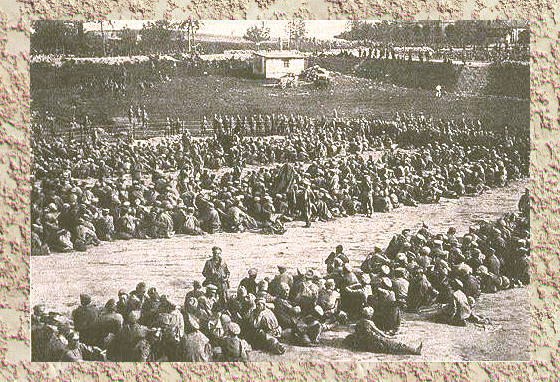
|
An Episode in the Battle of the Frontiers
By Christina Holstein
On 22 August, 1914, the French 3rd Colonial Infantry Division, marching
along the road from Rossignol to Neufchateau (Belgium) encountered the
German 6th Army Corps and, in a day of desperate fighting, were defeated
with losses of over 8500 officers and men. The loss of officers was
frightful and included all three generals (two killed and one wounded and
taken prisoner), almost all the officers of 1st Brigade and another 60
officers from 3rd Brigade. Only one officer survived from the divisional
artillery. The French put 32 guns out of action and the remainder were
either destroyed or captured. German losses were also serious but not as
high as the French.
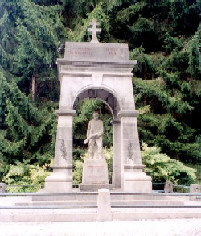
3rd Colonial Div. Monument |
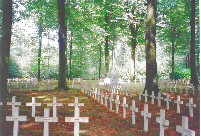
Cemetery at Rossignol
|
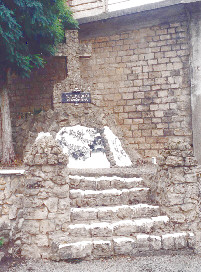
Marker Near Shoppach Bridge |
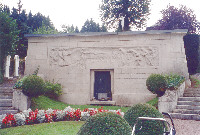
Mausoleum at Rossignol
|
On the following day, 122 civilians, mostly from Rossignol, were rounded up
by German troops and taken away to Arlon, where they were shot by Shoppach
bridge. The bodies, at first buried in a civilian cemetery at Arlon, were
returned to Rossignol after the war in the presence of the King of the
Belgians. The present mausoleum was inaugurated in 1925.
|
World War I Keeps Cropping Up
By Walt Kudlick
In the small Canadian town of Niagara-On-The-Lake (population 12,500 or so but with lots of tourists in the summer months) there is a cemetery with a small section bounded by a wrought iron fence and featuring three tall poles flying large Canadian, American and Polish flags. A bronze plaque contains the following information (abridged and edited): This burial plot commemorates the Polish soldiers who trained in this community from 1917 to 1919 at Camp Kosciuszko and subsequently made the supreme sacrifice. They personified the Polish soldier's motto: "For your freedom and ours!"
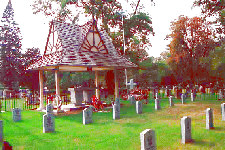
Polish Cemetery |
As a result of the movement to regain the independence of Poland and policy differences with the United States, 22,174 volunteers of Polish descent crossed the Niagara River from Youngstown, NY to this community and joined 221 Polish-Canadians for military training from 1917 to 1919. They were trained by Canadian officers and outfitted and financed by France. As a result they wore French uniforms and hence were called the "Blue Army." In Europe the volunteers were assigned to the Fourth French Army in battalion and regimental groups and participated on the Western Front in the Champagne sector of France in 1918. In October 1918 the battalion and regimental groups were united to form a separate Polish army, which with additional volunteers totaled 80,000. At the end of World War I, the soldiers were transported across Germany to defend the new found independence of Poland and repel the Bolshevik invasions. At this burial plot rest 25 of 41 soldiers who were stricken and died of influenza while in training.
|
| The following are thanked for their contributions to this issue of the Trip Wire: Christina Holstein, Diane Rooney, Tony Langley, Andy Melomet, Len Shurtleff, Walt Kudlick, Frank Jordan and Kathy Compagno. Until next month, your editor, Mike Hanlon. |
|



















